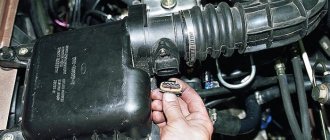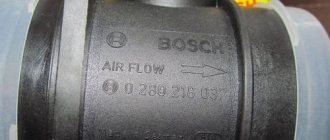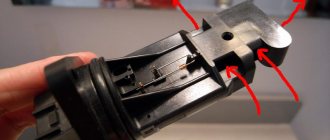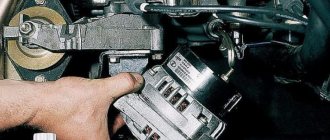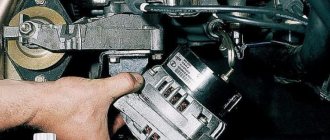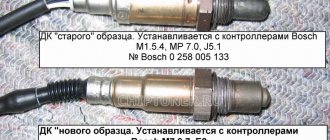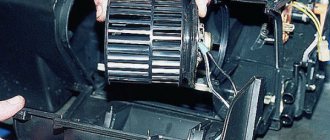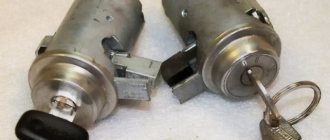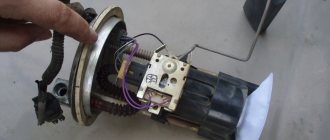09/26/2021 13 190 VAZ 2110
Author: Ivan Baranov
Any modern car is equipped with many different sensors that allow the driver to know about the condition and performance of certain components. And the VAZ 2110 car is no exception; in this article we will talk about what sensors are used in it and what their location is.
As you know, the VAZ 2110 injector with 8 or 16 valves is significantly superior to the carburetor version in many ways. At least because in this case the supply of gasoline, as well as the combustible mixture, is regulated by electronics. Accordingly, the use of electronics implies the use of many different regulators and controllers. Their breakdown can lead to certain consequences, so the car owner should always know what certain regulators are responsible for. Below we consider almost all VAZ sensors that are in the top ten.
[Hide]
A little history
The VAZ 2110 was produced from the end of the 20th century until the middle of the first decade of the 21st century. During its existence, the top ten managed to gain a huge number of fans and underwent a large number of changes.
The tenth VAZ family was initially equipped with 8-valve carburetor engines that had common roots from the G8 engines. Time moved forward and AvtoVAZ needed to develop further, and at the end of the 90s, an injection engine was installed on the top ten for the first time, which was distinguished not only by a new injection system, but also by the number of valves; some new engines received a doubled number of valves from 8- mi to 16.
To operate an engine with an injection system, you need a huge number of different sensors responsible for the operation of the internal combustion engine, and the VAZ 2110 is no exception; the dozens of injection engines have many different sensors installed that ensure correct and smooth operation of the engine.
In this article we will talk about VAZ 2110-12 sensors, their symptoms of malfunction and installation locations.
Mass air flow sensor (MAF)
It is one of the most important sensors. The mass air flow sensor is responsible for the formation of the air-fuel mixture. It measures the volume of air supplied to the intake receiver and transmits the readings to the electronic engine control unit, which in turn supplies the right amount of fuel in relation to air. The failure of this sensor affects many different functions of the internal combustion engine.
It should be noted that the “CheckEngine” lamp will light up only if the sensor fails completely. Most often, the sensor undergoes aging, but very rarely fails completely. You can read how to check this sensor in our article.
Signs of malfunction:
- Increased fuel consumption;
- Uneven idle speed;
- Difficulty starting the internal combustion engine;
- Loss of dynamics;
- Jerks when moving;
Diagnostics
To check the air flow sensor uses several methods in garage conditions. They can be done by any car enthusiast and do not require special skills or knowledge.
Easy test of the mass air flow sensor
The easiest way to check functionality: disconnect the sensor and start the car. If there is no sensor in the electrical system, the electronic control unit switches the engine to a safe operating mode. The combustible mixture is prepared only based on the position of the throttle valve. Try driving a few hundred meters - if the car moves “faster”, then it is faulty. It should be replaced.
How to check with a multimeter
The second method involves measuring the voltage between the sensor contacts with a voltmeter.
On a note. Such diagnostics are only possible with a Bosch mass air flow sensor with original numbers: 0 280 218 004, 0 280 218 116, 0 280 218 037.
Step-by-step instructions for DIY diagnostics
- Turn on the ignition, but do not start the engine.
- Switch the tester or multimeter to voltage measurement mode. Set the scale limit to 2 volts.
- Connect the probe with the red wire from the voltmeter to the sensor terminal (the yellow wire goes to it).
To make it easier to measure the output voltage, use a pin. Be careful not to damage the insulation
The serviceability of the sensor is judged by the voltage value. To help the driver, below is a small table:
| Range of values | Air flow sensor condition |
| 1,01 — 1,02 | good |
| 1,02 — 1,03 | satisfactory |
| 1,03 — 1,04 | resource is running out |
| 1,04 — 1,05 | "near-death" state |
| 1.05 and above | it's time to change |
Help from a friend
The third unique way to test the sensor is to have a friend help you. If you have a friend who owns a VAZ 2110, ask him to borrow his working mass air flow sensor. If after replacement the car with the friend sensor behaves differently, then the mass air flow sensor should be replaced.
Speed sensor
This sensor is designed to transmit readings to the engine ECU about the speed of the vehicle. It is involved in adjusting the engine speed when driving, namely, if the car is rolling in neutral, you will notice that the speed is slightly higher than the idle speed when the car is standing still. The DS is also responsible for the performance of the speedometer and odometer.
Signs of malfunction:
- Inoperative speedometer or odometer;
- There are no increased speeds when driving in neutral gear;
Coolant temperature sensor (DTOZH)
The DTOZH is installed in the thermostat housing and transmits readings to the ECU about the temperature of the engine coolant. Based on these readings, the engine control unit increases or decreases engine speed for more stable operation of the internal combustion engine. The operation of this sensor is noticeable on a cold engine; when starting the engine in the cold season, you can notice increased speed, which decreases over time as the engine warms up to operating temperature.
Signs of malfunction:
- Increased fuel consumption;
- Poor starting on a cold engine;
- Lack of warm-up speeds;
We check the mass air flow sensor on a VAZ-2110 with a multimeter
The sensor block, the first wire may not be there - this is normal.
To do this, we need to understand the pinout and the sensor connection diagram. As you can see, the block has only five wires:
- + 12 Volt.
- + 5 Volts.
- Total ground (green wire).
- Air temperature output signal.
- Air flow signal output (yellow wire).
Electrical diagram for connecting the mass air flow sensor.
The pinout may differ in different firmware versions and on different sensors. Everything is clear with the first two contacts - take a multimeter and check the presence of voltage when the ignition is on. If there is no signal, we look for the cause either in broken wires or in poor contact. Now we check the main indicator - the accuracy and magnitude of the air flow signal. By the way, this can be checked without a multimeter, using the on-board computer, if one is installed:
- We go to the menu, look for sensor parameters.
- Find the voltage Udmrv.
- The rating for all of the above modifications is from 0.996 to 1.01 V.
The platinum thread gets tired over time and distorts the impulse upward. A change of even one hundredth of a Volt is unacceptable. If the computer is not installed, we use a multimeter. We check the voltage between 3 and 5 (minus) contacts , setting the measurement limits on the multimeter to 2 V. Turn on the ignition, but do not start the engine.
The scale shows 1.00 - the sensor is in excellent condition.
On a scale of 1.26 – the sensor is “dead”.
Check table
We evaluate the result using this table:
| See all advertisements in the archive |
| 0.99-1.02 V | The condition of the air flow sensor is excellent, close to new |
| 1.02-1.03 V | Sensor in good condition |
| 1.04-1.05 V | The platinum thread is worn out, you need to think about replacing the sensor |
| More than 1.05 V | The sensor does not work, urgent replacement is necessary |
Crankshaft position sensor (CPS)
DPKV is a sensor that counts crankshaft revolutions. Just like most sensors, it participates in the formation of the fuel mixture. If it malfunctions, the car will not start.
The sensor is installed on the rear of the engine under the oil filter. Works in tandem with the crankshaft pulley (generator drive).
Signs of malfunction:
- The car does not start (no spark);
- Jerks when moving;
- Spontaneous engine stop;
Phase sensor (PF)
This sensor is necessary for counting camshaft revolutions; its functions are similar to those of the DPKV. Designed for phased fuel injection; without this sensor, the internal combustion engine will operate in emergency mode and the fuel supply will switch to pairwise mode.
It is installed under the timing cover on 16-valve engines, and on 8-valve engines on the end of the cylinder head on top of the thermostat.
Signs of malfunction:
- Increased fuel consumption;
- Unstable work at XX;
- Loss of dynamics;
Idle speed sensor design
Composition of IAC:
- a small electric motor with a stepper type action;
- a rod with a calibrated thick needle-shaped cone and a spring;
- terminals for the block.
Idle air control (IAC)
This sensor is installed on the throttle valve and regulates the air supply when the car is running at idle. In other operating modes of the internal combustion engine, the idle air regulator is not involved. The sensor performs mechanical functions, so if it malfunctions, the “CheckEngine” warning light does not light up.
If the regulator breaks down, you can wash it and try installing it again. If washing does not help, the sensor must be replaced with a new one.
Signs of malfunction:
- Unstable idle;
- The engine stalls when coasting;
- Difficulty starting the engine;
- Low speed XX;
Replacing and calibrating a new IAC
Replacing the idle speed valve sensor on a VAZ 2110: the part is inserted, the screws are tightened, the leads are connected according to the diagram (available in the instructions for the IAC or on the network). The idle speed control of the VAZ 2112 has 16 valves and on other vehicles with a power system of a similar design, it is located in the same standard way.
It is highly advisable to calibrate the IAC after replacement:
- Ignition for 7–10 seconds, without starting during this time.
- Start the internal combustion engine. Jumps and increased speed may be observed.
- Turn off the engine - the rod will move to another extreme position.
- Repeat the described steps 2-3 times.
- Run the engine for approximately 5–7 minutes.
It must be remembered that the calibration is reset after disconnecting the IAC or after removing the negative terminal from the battery. This procedure will help the speed “stand up” more correctly for better functioning of the system.
Throttle Position Sensor (TPS)
TPS is designed to transmit indications about the position of the valve in the throttle assembly. The received readings are transmitted to the ECU for further regulation of the fuel mixture. This sensor fails quite often. Located on the throttle valve above the IAC.
The sensor cannot be repaired and if it breaks, it is replaced with a new one.
Signs of malfunction:
- Spontaneous increase and decrease in speed;
- Difficulty starting the engine;
- Increased fuel consumption;
- Low speed XX;
Coolant temperature indicator
Coolant, as you already know, is a coolant. It also has its own special sensor. In its functions, it resembles a choke, which is installed on carburetor versions of the VAZ 2110 and others.
Device that reads coolant temperature
That is, this sensor is responsible for regulating the fuel. The colder the engine is, the more fuel it will receive. This indicator is characterized by certain breakdowns:
- Electrical contact inside the regulator may be broken;
- Near the accelerator cable there are wires that often lose their insulation;
- The sensor fails if the fan starts to operate when the power unit is cold;
- Certain difficulties arise when starting a very hot engine;
- If the sensor breaks down, increased fuel consumption occurs.
Oil pressure sensor (OP)
This sensor signals the condition of the oil pressure in the engine. When it decreases, a lamp on the car’s dashboard lights up in the form of a red oil can. The sensor is completely mechanical and is only responsible for turning on the low oil pressure indicator.
Signs of malfunction:
- The oil pressure lamp does not light up;
- The oil pressure lamp is constantly on;
Oxygen sensor (OS)
The VAZ 2110 oxygen sensor is installed in the exhaust manifold. The DC measures the exhaust gases and uses their readings to determine the ratio in which the fuel mixture is formed. If the readings exceed the permissible values, the ECU adjusts the air-fuel mixture in such an amount that the exhaust gases do not exceed the permissible values.
Signs of malfunction:
- Increased fuel consumption;
- Loss of vehicle dynamics;
- Black smoke when driving at high speeds;
